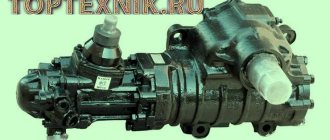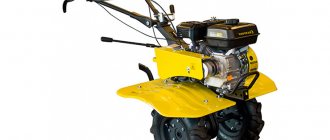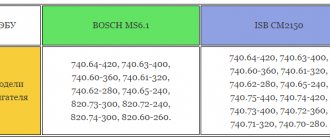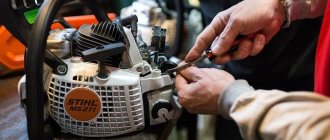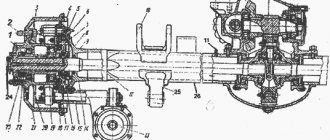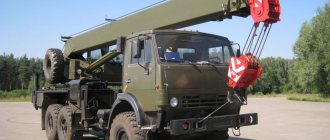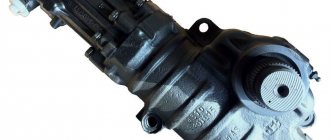Symptoms of malfunction of fuel injection pump KAMAZ 740, fuel injection pump KAMAZ 4310
Malfunctions of fuel pumps and regulators manifest themselves in a violation of adjustment due to wear of parts, which results in the occurrence of extraneous noise, overheating and fuel leakage.
The main reason for the malfunction of the fuel pump is wear of its parts, weakening of the tightness in the fits, increased gaps in the moving joints, violation of the location of the parts, and deposits on the surface of the parts in the form of dirt and carbon deposits.
The consequence of pump malfunctions can be a decrease in the supply of fuel in the required quantity and uneven supply. Failure to properly supply fuel is usually caused by wear of plunger pairs, pump discharge valves, plunger drivers, rack clamps, rack teeth and bushing gears, and clogging of injectors. Such malfunctions lead to a decrease in engine power and efficiency.
Uneven supply of fuel to the engine cylinders will lead not only to unstable operation at low speeds, but also to interruptions in the operation of individual cylinders, which will be accompanied by vibration of the engine block.
Fuel injection pump malfunctions include uneven start of injection and delay in injection timing of a multi-section pump, which occurs due to wear of the pusher adjusting bolt, roller axis, pusher and roller housing, ball bearings, as well as wear of the cam shaft.
Wear of plunger pairs and injection valves significantly affects the change in the fuel injection advance angle.
Kamaz 4310 2 doors. chassis, 210 hp, 5 manual transmission, - the engine slowly picks up speed
content .. 965 966 967 ..The engine revs up slowly (causes and solutions)
When operating a gasoline or diesel engine, the driver may encounter the fact that when pressing the gas, the engine does not gain speed. Note that after installing LPG on a car, a problem often arises when the engine does not pick up speed on gas, although the car drives normally on gasoline. Malfunctions of various kinds can be hidden either in fairly simple things or indicate the need for serious repair of the internal combustion engine. Next, we will look at why a diesel engine does not pick up speed or a gasoline engine refuses to spin up.
If the engine has stopped gaining momentum, then the first thing you need to do is analyze when and how this manifested itself. In other words, the unit stopped spinning unexpectedly, or the problem with gaining speed gradually progressed. You should also pay attention to the presence or absence of other symptoms.
The fact is that the failure of a previously serviceable engine to gain speed after any repairs or other manipulations may simply be the result of assembly errors, a not connected sensor, etc. In such cases, the malfunction can be quickly and accurately determined after an independent inspection or immediate return of the vehicle to the service center where the car was previously repaired.
If you are faced with the fact that the engine stalls for no apparent reason, does not pick up speed, the car periodically stalls, etc., then in this case the engine needs in-depth diagnostics. The causes of such a breakdown can be divided into simple and complex, arising immediately or having received prerequisites. Why the engine does not gain momentum: from simple to complex
At the very beginning, let's look at simpler and more obvious faults. The set of revolutions while driving is greatly influenced by the efficiency of delivery, the timing of ignition and the completeness of combustion, as well as the composition of the fuel-air mixture.
A common reason why an engine does not pick up speed (injector, carburetor, diesel, gas car) is problems in the ignition system, as well as in the air and fuel supply systems. Experts highlight the following:
Severe contamination of the air filter reduces the ability of air to penetrate through the filter element, as a result of which the engine becomes uneven, the unit loses power and does not gain speed. Another common cause of air supply problems may be that a foreign object (rag, plastic bag, etc.) may accidentally end up in the air filter housing. You should also pay attention to the leakage of excess air at the intake as a result of various defects in the intake system. The problem can appear unexpectedly or gradually progress. Note that the engine usually does not gain speed in case of strong air leaks. The fact is that in the composition of the fuel-air mixture, the normal ratio of air and fuel in such a situation noticeably deviates from the norm. The mixture turns out to be very “lean” (lots of air and minimal fuel). With such a charge, the engine starts, but does not gain speed while driving, and also runs intermittently. A similar picture can be observed when the required amount of fuel is not supplied to the unit. The culprit may be the fuel filter, which can also become severely clogged. Note that there may be no problems with starting the engine, since there is enough fuel for the XX mode. At the same time, while driving, the car may twitch, react to pressing the gas pedal with a long delay, dips may occur when the speed increases, or the unit may not spin above a certain mark on the tachometer. A dirty fuel pump mesh filter can also lead to similar symptoms. Deposits from the fuel tank tend to accumulate on this filter over time. As a result, the fuel pressure in the system becomes insufficient, the pump performance drops, and the engine itself is not able to operate normally in different modes. It often happens when the engine picks up speed and stalls precisely because the grid is clogged. Replacing the fuel pump mesh. We also recommend reading the article on how to clean or replace the fuel pump mesh yourself. From this article you will learn about the installation location of this fuel pump grid, as well as the available methods for cleaning it yourself. If the spark plugs or high voltage wires are not working properly, then the mixture may not ignite properly. As a result, ignition of the fuel charge in the cylinder may occur untimely, engine power drops, and speed does not increase. Such consequences are caused by oiling or contamination of spark plugs (especially on internal combustion engines with a significant mileage), damage to the spark plug body, and incorrectly set gaps on the electrodes. Also, the appearance of a spark and its quality can be directly affected by the breakdown of high-voltage spark plug wires, as well as their breaks. In such cases, the engine begins to stall, misfires and misfires are observed, and the speed gain deteriorates. The driver can identify most of the above reasons and fix them relatively cheaply on his own. It is necessary to check the spark plugs and wires of the ignition system for a spark, measure the pressure in the fuel rail on fuel-injection internal combustion engines, inspect the air filter for contamination, replace the fuel filter, clean the fuel pump mesh, etc. Now let's talk about problems that may require certain knowledge, skills and equipment for diagnosis, and also be a reason for a visit to a car service center. Let's start with the fact that this list of faults usually includes those when the engine does not gain speed due to the failure of any element of the ECM, ignition system, power supply, etc. In other words, we are no longer talking about “consumables” (spark plugs, wires, filters, pipes), but about details. In parallel with this, one should also take into account whether the breakdown occurred unexpectedly or whether the fault progressed gradually.
One of the reasons may be misaligned timing. Violations of the synchronous operation of the gas distribution mechanism regarding the intake and exhaust strokes lead to the fact that the intake and exhaust valves open untimely. The malfunction occurs as a result of errors during timing belt replacement if said timing belt has jumped one tooth or more teeth. Also, the cause may be incorrectly adjusted valves (the problem does not manifest itself sharply), various problems in variable valve timing systems, breakdown of the timing chain drive, etc. Unexpected breakdowns include failure of the ignition module, as well as malfunctions of the ignition coils. In this case, the cylinders begin to misfire, the engine stalls and loses the ability to gain speed normally. In situations with engine speed, the power supply to the injection nozzles should be checked. If problems arise with the wiring, then the control signal is not supplied to the injector or is received intermittently. As a result, the injector does not open in a timely manner, misfires occur in one or more cylinders, the engine does not reach the required speed and loses power. The fuel pump or fuel injection pump on diesel engines may fail. This problem usually does not occur immediately (except in cases where the electrical wiring to the pump is damaged). Much more often, the decrease in pump performance occurs gradually. Sooner or later, the pump will begin to pump fuel very weakly; the pressure will only be enough to operate in idle mode. An increase in load and speed will lead to the engine stalling under load, not spinning up, etc. In some cases, severe contamination of the injector itself leads to similar results. Driving on low-quality fuel, as well as ignoring the necessary procedure for cleaning injectors every 30-40 thousand kilometers driven, can mean that the performance of one or more fuel injectors has dropped significantly. Engine speed can also be affected by the condition of the EGR system, the throughput of the catalyst or particulate filter. As for the second case, due to a clogged catalyst, exhaust gas removal deteriorates, the engine literally “suffocates” and is not able to gain normal speed. At the same time, it is necessary to check various sensors of the electronic engine management system. Their incorrect operation can affect the composition of the mixture, that is, the amount of fuel and air supplied to the internal combustion engine. Such sensors include TPS, DMRV and a number of others.
Eventually
Considering that there are many reasons for problems with revving on a modern car, it is optimal to immediately connect the car to diagnostic equipment (scanner) to search for possible errors. This is especially necessary to do in the case when the engine does not pick up speed and the check light on the dashboard lights up.
Note that a fairly rare, but also possible, case is the failure of the ECU. This often happens after washing the engine, as well as as a result of unprofessional interventions in the factory firmware of the controller. A sign of problems with the electronic unit is that the engine picks up speed but loses speed. Such failures are associated with a software malfunction in the operation of the electronic device. The ECU mistakenly takes low speeds (for example, 2-3 thousand rpm) for the so-called “cut-off” speed and stops the fuel supply. In other words, the conditional protection against exceeding the permissible maximum engine speed is triggered prematurely.
Finally, I would like to add that timely cleaning of the injector, replacing spark plugs and ignition wires, filters and fuel pump filter elements, cleaning the throttle valve, correct throttle adjustment and a number of other service procedures will allow you to get maximum power from your internal combustion engine. As for cars with gas equipment, not only the engine power and its speed on gas, but also the overall service life of the power unit will depend on the correct installation and configuration, as well as on the timely replacement of filters and maintenance of other elements of gas equipment.
Specifications
Technical characteristics of KamAZ 4310 in a body of 2 doors. chassis with a 210 hp engine, 5 manual transmission produced since
Basic data
- Start of production:
unknown - End of production:
in production
- Body:
2 doors chassis
Engine
- Engine type: V8
- Fuel grade: diesel fuel
- Engine capacity, cubic meters see: 10850
- Supercharging: Turbocharging
- Power, hp: 210
- Achieved at vol. per minute: 2600
- Torque, Nm/rev. per minute: 637/1600-1800
- Maximum speed, km/h: 85
- Compression ratio: 17
Transmission
- Transmission: Manual
- Number of steps: 5
Suspension
- Front: Spring
- Rear: Spring
Brakes
- Front: Drum
- Rear: Drum
Dimensions
- Length, mm: 9520
- Width, mm: 2500
- Height, mm: 3450
Other
- Number of seats: 3
- Curb weight, kg: 8795
- Permissible weight, kg: 15205
content .. 965 966 967 ..
The main reasons why the KAMAZ engine does not start:
- There is no fuel in the fuel tank;
- Presence of air in the fuel system;
- Clogged or contaminated fuel lines of the KAMAZ power supply system;
- The fuel has thickened due to low temperatures;
- Malfunctions of the high pressure fuel pump (injection pump malfunctions)
- Clogged fuel filters.
To determine the malfunction of the power system, you should follow the chain from less expensive and costly faults to more costly ones, taking into account the flow chart for repairing the power system.
Why is the internal combustion engine not gaining momentum?
The Kamaz engine does not develop speeds above 2000 for many reasons. This may be due to problems in the fuel system, faults in the vehicle's electrical wiring, or a breakdown in the engine control unit.
Frequent breakdowns due to which the power unit does not develop speeds above 1700:
- Air filter clogged.
- Malfunction in the high pressure fuel pump.
- Fuel system clogged.
- Damage to the power unit control unit.
- The fuel supply angle is incorrect.
- Clogged injectors.
If the Kamaz develops poorly and smokes, this is a reason to seek help from experienced specialists for repairs. Trying to fix a problem in a truck yourself can only make the situation worse, and in the end the repair will cost significantly more.
The problem with a drop in power unit speed can occur with any engine, regardless of Kamaz Euro 3, Kamaz Euro 4 or Kamaz Euro 5. The difference may only lie in the features of troubleshooting. The higher the standard of the internal combustion engine, the more difficult the repair can be.
The KAMAZ 740 engine does not develop full power
- Replace the air filter;
- Adjust the fuel supply angle;
- Clean the injectors, adjust the injectors;
- Repair the injection pump;
- Check the operation of the KAMAZ injection pump.
Uneven operation of the KAMAZ 740, KAMAZ 4310 can be caused by loss of functionality of individual injectors, a malfunction of the high-pressure fuel pump or its regulator. Damaged injectors must be replaced, and the injection pump, as a more expensive part, is checked on a fuel stand and repaired if necessary.
Description of faults
When the car does not develop speed in 4th gear, this indicates that the engine is not receiving enough fuel to provide full power. Basically, the reason lies in clogged injectors or a failed injection pump.
The high pressure fuel pump is a complex mechanism. If its individual moving part is worn out, the efficiency of the motor decreases. This may increase fuel consumption due to increased gaps between moving elements. Due to a faulty fuel injection pump, the engine cylinders receive insufficient or uneven amounts of fuel.
Frequent problems with injection pumps include wear of plunger pairs, plunger drivers, discharge valves, and clogging of injectors. Uneven supply of fuel to the cylinders provokes not only a decrease in power, but also causes increased vibration of the cylinder block.
Repairing an injection pump is quite difficult, so it is better to entrust the restoration of its normal operation to a professional technician. guarantees its clients high-quality work in the shortest possible time.
KAMAZ does not pull - Main reasons
Automotive technology has become a part of everyday life. Today, not a single industry can do without the help of transport. In terms of freight and passenger transportation, the products of the Kama Plant (KAMAZ) occupy a leading position in the market. Despite the reliability and quality, owners are faced with the fact that the KamAZ engine does not work.
This is a common phenomenon because there are many reasons for it. You need to start with a banal discrepancy between the fuel and the required quality, and end with a breakdown of the power plant, requiring prompt intervention. Let's try to figure out why KamAZ doesn't work, what are the prerequisites and solutions to the problem.
Video “Getting Error Codes”
The video shows an example of receiving error codes 36 and 37.
Automotive technology has become a part of everyday life. Today, not a single industry can do without the help of transport. In terms of freight and passenger transportation, the products of the Kama Plant (KAMAZ) occupy a leading position in the market. Despite the reliability and quality, owners are faced with the fact that the KamAZ engine does not work.
This is a common phenomenon because there are many reasons for it. You need to start with a banal discrepancy between the fuel and the required quality, and end with a breakdown of the power plant, requiring prompt intervention. Let's try to figure out why KamAZ doesn't work, what are the prerequisites and solutions to the problem.
Characteristic signs and causes
Faced with a problem of this kind, the user tries to figure out why the KamAZ truck does not work and the reasons for this behavior of the equipment. This is connected with the power plant, so the search for a solution takes place in this plane.
As a rule, the first steps are to diagnose the power plant. This approach saves search time and also indicates the nature of the breakdown.
KamAZ, “floating” engine speed:
A harmless reason is the lack of traction on the new KamAZ vehicle. This is due to the running-in of the vehicle - grinding in parts and mechanisms to each other. This behavior is considered normal and disappears when the car travels 5,000-10,000 kilometers.
Fuel system malfunction
It is quite likely that the reason for the drop in the thrust of the KamAZ engine is a violation of the normal operation of the fuel supply system to the cylinders, and there may also be a number of reasons why the Kamaz engine does not gain momentum.
If you still have questions, now you can ask them on our forum of amateur and experienced Kamaz drivers
Automotive technology has become a part of everyday life. Today, not a single industry can do without the help of transport. In terms of freight and passenger transportation, the products of the Kama Plant (KAMAZ) occupy a leading position in the market. Despite the reliability and quality, owners are faced with the fact that the KamAZ engine does not work.
This is a common phenomenon because there are many reasons for it. You need to start with a banal discrepancy between the fuel and the required quality, and end with a breakdown of the power plant, requiring prompt intervention. Let's try to figure out why KamAZ doesn't work, what are the prerequisites and solutions to the problem.
Severe wear of engine parts
This problem is an unpleasant reason for the owner of a KamAZ car. As a rule, the behavior is typical for old cars that are used intensively. The problem also manifests itself on new equipment that was used in harsh conditions in violation of standards.
KamAZ engine, severe wear of parts:
The rings and cylinders of the power plant are subject to wear, as loaded engine parts. The first sign, a drop in compression, is checked first. For a KamAZ diesel engine, the compression indicator is at least 20 kg*cm2. If the compression is lower, the unit is repaired.
Sometimes it is necessary to clean the cylinder head and valves from accumulated coke. To do this, the head is dismantled and the procedure for cleaning and lapping the valves is carried out.
Filter elements
There is a situation when the KamAZ 3110 does not pull uphill, the reason for this lies in the lack of fuel entering the engine combustion chamber. Another characteristic feature is that the car twitches, the power plant does not work confidently.
A common cause is a clogged filter element. As a rule, a KamAZ vehicle is equipped with two fuel filters - coarse and fine. The coarse filter is installed in conjunction with the fuel pump, or is inserted into the fuel supply. A thin filter is located directly in front of the injectors. If one filter element does not perform its function, the engine does not have enough fuel. As a result, the motor does not use its full potential.
KamAZ, fuel filter:
In addition, the purity of the air supplied to the cylinder is important for mixture formation. The air filter element is responsible for this indicator. Often, the air filter becomes clogged in the summer, when the car is used in conditions with high dust concentrations. Dirty air does not allow the working mixture to fully burn, as a result, power is lost, the unit does not pull, and fuel residues are deposited in the form of deposits inside. To avoid these troubles, filter elements are changed as needed.
Poor quality fuel
First of all, you need to blame the fuel - remember where you last refueled - perhaps it is a new gas station or one with fuel you have not previously had experience driving with. It is quite possible that the fuel simply turned out to be of very poor quality (it happens that you will simply be lucky if your engine simply stops running - after all, someone’s engine will probably stop starting altogether until the owner completely replaces the fuel in the tank). Dirty air filter You may also simply have a dirty air filter, and in this case, eliminating the loss of power will probably cost you less than all other options - just replace the air filter on your KamAZ.
Glow plugs
The glow plug, located in the combustion chamber, is an integral element of a modern diesel engine. The part helps to ignite the fuel charge and makes the combustion intense. Considering the fine-tuning of modern engines, a malfunctioning spark plug leads to a loss of unit power, and at temperatures of +5° and below, it becomes difficult to start the engine.
KamAZ, glow plug:
To avoid troubles, monitor the instrument panel readings: a non-working glow plug indicator is the first sign of a problem. In addition, if the indicator burns longer than expected, it indicates a malfunction of the thermal switch or temperature sensor.
Carrying out diagnostics of glow plugs will help to avoid problems with loss of power.
Exhaust
In pursuit of environmental standards and compliance with Euro standards, modern internal combustion engines are equipped with catalysts, afterburning mechanisms, and probes. Therefore, moments when KamAZ, which meets Euro 4 standards, does not meet the requirements, occur frequently. The point is the catalyst, the inside of which contains a special composite filter. The filter components further purify the gases. If you use fuel that does not meet the established standards, the filter quickly becomes clogged and fails. Sensors automatically reduce the speed of the power plant, as a result, the car produces insufficient power. To fix the problem, the part is changed.
KamAZ engine malfunctions
Possible malfunctions of the KamAZ engine
| Cause of malfunction | Elimination method |
| KamAZ engine does not start | |
| The starter does not turn the crankshaft or turns it very slowly | See the section “Possible starter malfunctions and how to eliminate them” |
| Empty fuel tank | Fill the fuel tank, bleed the power system |
| Air in the fuel system | Eliminate leaks, bleed the power system |
| The adjustment of the fuel injection advance angle has been disrupted | Adjust the fuel injection timing angle |
| Faulty electric torch device (EFD) to facilitate starting (during the cold season) | See the section “Possible malfunctions of the EPU and how to eliminate them” |
| Water that got into the fuel lines or onto the fuel tank intake screen has frozen. | Carefully warm the fuel filters, pipes, tank with a rag moistened with hot water or steam; do not use open flames for heating |
| The KamAZ engine does not develop the required power, is unstable and smokes | |
| The air cleaner or air intake hood is clogged | Service the air cleaner or clean the hood mesh |
| Insufficient fuel supply | Replace the fine fuel filter elements, wash the coarse filter, tighten the connections in the fuel lines |
| The adjustment of the fuel injection advance angle has been disrupted | Adjust the fuel injection timing angle |
| The nozzle is clogged (coking of the nozzle holes, needle hangs) or its adjustment has been disrupted | Wash the nozzle, check and adjust if necessary |
| The governor control lever does not reach the maximum crankshaft speed limitation bolt | Check and adjust the speed control drive |
| The high pressure fuel pump pusher spring is broken | Replace the spring and adjust the pump on the bench |
| Dirt has gotten between the seat and the valve of the fuel priming pump or the spring has broken | Clean the valve or replace the spring; check the operation of the pump on the stand |
| The high pressure fuel pump discharge valves are leaking or the spring is broken | Have valve leaks repaired in a workshop or replace the spring |
| The plunger of the high pressure fuel pump section is jammed | Replace the plunger pair and adjust the pump |
| The adjustment of thermal clearances in the gas distribution mechanism has been disrupted | Adjust the gaps |
| Poor compression due to malfunctions of the piston group or loose fit of the gas distribution valves to the seats | Check the condition of the pistons and piston rings; lap the valves |
| The fastening is loose or the high pressure pipe has burst | Tighten the fastening nut or replace the tube |
| Fuel has thickened (during the cold season) | Replace the fine filter elements of the fuel, wash the coarse filter, replace the fuel with the appropriate one for the season; bleed the power system |
| KamAZ engine knocks | |
| Early injection of fuel into the cylinders | Adjust the fuel injection advance angle |
| Increased thermal clearances in the gas distribution mechanism | Adjust the gaps |
| The timing valves are stuck in the bushings (the piston touches the valve) | Disassemble and wash the valve mechanism. Replace valve if necessary |
| Increased cyclic fuel supply (rack lock disengaged) | Replace the high pressure fuel pump rack |
| Knock of the crankshaft. Knock of a dull tone. The frequency increases with increasing engine speed. Excessive axial clearance causes a sharper knock at uneven intervals during smooth acceleration and deceleration | |
| The oil does not comply with what is specified in this manual. | Change the oil |
| Insufficient pressure and oil supply. Unacceptably increased gap between the journals and main bearing shells | Check the operation of the oil pump. Grind the journals to the repair size and replace the liner |
| Unacceptably increased gap between the thrust half-rings and the crankshaft | Replace the thrust half-rings with new ones of increased thickness. |
| The bolts securing the flywheel to the crankshaft are loose | Determine the cause and tighten the bolts |
| The knock of the connecting rod bearings is sharper than the knock of the main bearings. It is heard when the engine is idling and the gear shift lever is in neutral position, and intensifies with increasing crankshaft speed. | |
| The oil does not comply with what is specified in this manual. | Change the oil |
| Insufficient oil pressure | Check the operation of the lubrication system |
| Unacceptably increased clearance between the crankshaft connecting rod journals and the bearings | Grind the connecting rod journals to the repair size and replace the bearings |
| Piston knock Muffled, caused by the beating of the pistons against the cylinders. It can be heard at low crankshaft speeds and under load. | |
| Unacceptably increased gap between pistons and cylinders | Replace pistons and, if necessary, cylinder liners |
| The ends of the piston rings and the corresponding grooves on the piston are severely worn | Replace piston rings, pistons if necessary |
| The knocking of the piston pins is sharp and double, caused by a large gap. Better heard when the engine is idling. | |
| Unacceptably increased gap between the pin and the bushing of the upper connecting rod head | Replace the pin and, if necessary, the connecting rod |
| Reduced pressure in the lubrication system * | |
| High oil temperature | Open the oil radiator valve; troubleshoot the oil cooling system |
| The filter elements of the oil filter are dirty | Replace filter elements |
| Oil pump intake clogged | Wash the intake |
| Leaks and leaks in the lubrication system | Check the fastening of the oil pump, intake and oil lines, oil filters, and oil cooler for leaks; fix the problem |
| Oil pump valves are clogged or faulty | Clean valves, replace broken springs |
| Unacceptably increased clearance in crankshaft bearings | Replace the crankshaft bearing shells |
| Increased pressure in the lubrication system * | |
| High oil viscosity | Change the oil to the appropriate one for the season |
| The lubrication system valve is stuck | Check the valve and remove any sticking, replace faulty parts if necessary |
| Increased fluid temperature in the cooling system * | |
| The fluid coupling switch is set to position “O” | Move the switch lever to position “A” |
| The fluid coupling switch is faulty | Temporarily move the switch lever to position II; adjust the switch as soon as possible |
| Water pump drive belts are loose or broken | Tighten or replace belts |
| Thermostats are faulty | Replace Thermostats |
| The outer surface of the radiator core is dirty | Clean dirt from the radiator core |
| Increased coolant consumption | |
| Radiator damaged | Troubleshoot or replace radiator |
| Liquid leakage through connections in the cooling system | Tighten connections; if necessary, replace gaskets and O-rings |
| Fluid leaking through the mechanical seal of the water pump | Replace the mechanical seal |
| Coolant enters the lubrication system through the rubber O-rings of the cylinder liners or through the rubber cylinder head gasket | Replace cylinder liner O-rings or cylinder head rubber gasket |
| The KamAZ engine does not develop the required power and smokes | |
| Low charge air pressure: | |
| — air leakage through the connections of the intake manifold with the cylinder heads, pipes, turbochargers and air brake compressor; | Tighten connections, replace gaskets and connecting hoses if necessary |
| — breakthrough of gases in the connections of the exhaust manifold and turbine housing; | Tighten connections, replace gaskets if necessary |
| — jamming of the turbocharger rotor | If the rotor rotates tightly and touches the housing parts, replace the turbocharger |
| — contamination of the compressor or turbine flow parts | Remove the turbocharger and remove deposits from the flow parts |
| Extraneous noise in the turbocharger | |
| The rotor touches the housing parts | Tighten the bolt securing the turbine and compressor housings. Check that there is no interference with the rotor at its extreme axial positions; if the rotor catches, replace the turbocharger |
| Increased oil consumption | |
| Prolonged engine operation at idle speed | Do not operate the engine at idle speed unless necessary. |
| Oil leakage through connections in the turbocharger lubrication system | Tighten connections, if necessary, replace gaskets and rubber sealing rings |
| The air filter or air intake hood is clogged | Service the air filter or clean the hood mesh |
Electronic control systems KAMAZ
Recently, engines from the Kama Automobile Plant began to be classified according to their belonging to one or another environmental class (from Euro-0 to Euro-4). The technical implementation of the Euro-3 class, and then Euro-4, adopted in 2013, turned out to be impossible without the use of electronic engine control systems (ECM). This is what led to the opportunity to perform self-diagnosis of the car using KAMAZ universal error codes.
Ecological class Euro-4
Various configurations of KAMAZ trucks began to be equipped with engines with electronic control units (ECU). And if now the driver is concerned about unhealthy behavior during the operation of famous trucks, symptoms appear in the form of floating speed, loss of traction, unusual noises, increased diesel fuel consumption, self-diagnosis comes to the rescue.
Using information output from the ECU in the form of an error code, it is possible to indicate an accurate electrical diagnosis for KAMAZ. The process of diagnosing and deciphering codes depends on the type of electronic system installed on the truck. Before starting diagnostics, it is suggested to determine the type of ECU based on the installed engine model.
Engine Model Table
Self-Diagnostics No matter what company your V8 is made by, Cummins Inc. (Cummins) or KAMAZ LLC, it is equipped with fuel supply systems from Common Rail and exhaust gas recirculation (EGR) or neutralization systems (SCR), diagnostics will be carried out in accordance with these two types.
The process of self-diagnosis of KAMAZ electronic systems in Euro-3, -4 engines differs slightly from a similar procedure in other vehicles. After pressing a certain button, one of the lamps on the dashboard or indicator unit will begin to blink at different intervals; the number of flashes of the lamp at one interval determines the digit of the code.
Engine with ECU BOSCH MS 6.1
So, let’s get comfortable in the cabin of our KAMAZ, then turn on the ignition with the usual turn of the key. Along with many other indicators, the diagnostic indicator light or “Check Engine”, or in common parlance, a submarine, lights up. The lamp lights up for 3 seconds and goes out, thereby demonstrating its functionality and the serviceability of the ECM. If the lamp does not go out or lights up while the engine is running, a malfunction has been found in the electronic system!
Diagnostic indicator lamp
Let's pay attention to the diagnostic mode rocker button (often mounted on the instrument panel on the left, under the steering wheel) or the button for this mode (often located next to the fuse box, under the panel opposite the passenger seat). The “rocker” has two extreme positions for holding and a central fixed position.
Lower the rocker to its highest or lowest position and hold it there for more than two seconds. Just press the button and do not release it for the above-mentioned time. After the rocker or button returns back, the diagnostic lamp will flash first in long intervals and then in short ones. The number of long flashes determines the first digit of the error code, the number of short flashes determines the second digit.
Blink Code Alarm Diagram
The diagram shows an example of obtaining code 24. We compare the error code (otherwise blink code, from the English blink - blink) with the table below.
| Error codes for the BOSCH MS6.1 ECU of Euro-3 eco-class engines | ||
| Error code | Description of the malfunction | Operating restrictions set by the ECU |
| 11 | gas pedal | engine speed is limited to 1900 rpm |
| 12, 13 | atmospheric pressure sensor | not limited |
| 14 | clutch sensor | engine speed is limited to 1900 rpm |
| 15 | crankshaft rotation frequency sensor | engine speed is limited to 1600 rpm |
| 16, 17 | Incorrect polarity of frequency rotation sensors; sensors are not installed correctly | engine speed is limited to 1800 rpm |
| 18 | frequency camshaft rotation sensor | engine speed is limited to 1800 rpm |
| 19 | main relay | not limited |
| 21, 22, 24—26 | high pressure fuel pump | engine start failure |
| 23 | inappropriate position of the gas and brake pedals | not limited |
| 27 | poor contact of rack position sensor | engine start failure |
| 28 | brake pedal sensor | not limited |
| 29, 51—53, 81—86, 99 | electronic control unit | engine start failure |
| 31, 32 | air temperature sensor | not limited |
| 33, 34 | air pressure sensor | not limited |
| 35 | cruise control module | not limited |
| 36, 37 | liquid cooling temperature sensor | engine speed is limited to 1900 rpm |
| 38, 39 | fuel temperature sensor | engine speed is limited to 1900 rpm |
| 41 | the signal from the multi-stage input does not correspond to the reference | not limited |
| 42 | maximum engine speed exceeded | The wrong gear may have been selected. Resetting the error when starting the engine again |
| 43 | speed signal error | engine speed is limited to 1500 rpm |
| 54 | excess on-board voltage | not limited |
| 55 | The control unit operation cycle is not completed correctly | not limited |
| 61—67 | CAN line | not limited |
